Alcohol Consumption and Health Consciousness
VerifiedAdded on 2020/06/06
|10
|2452
|349
AI Summary
This assignment examines the relationship between alcohol consumption and health consciousness in Australia. It analyzes data collected through a survey to investigate whether individuals who are more health-conscious tend to drink less alcohol. The analysis explores factors such as fear of health consequences, social pressure, and perceived benefits of alcohol consumption. Additionally, it discusses the effectiveness of different message frames in influencing alcohol consumption intentions.
Contribute Materials
Your contribution can guide someone’s learning journey. Share your
documents today.
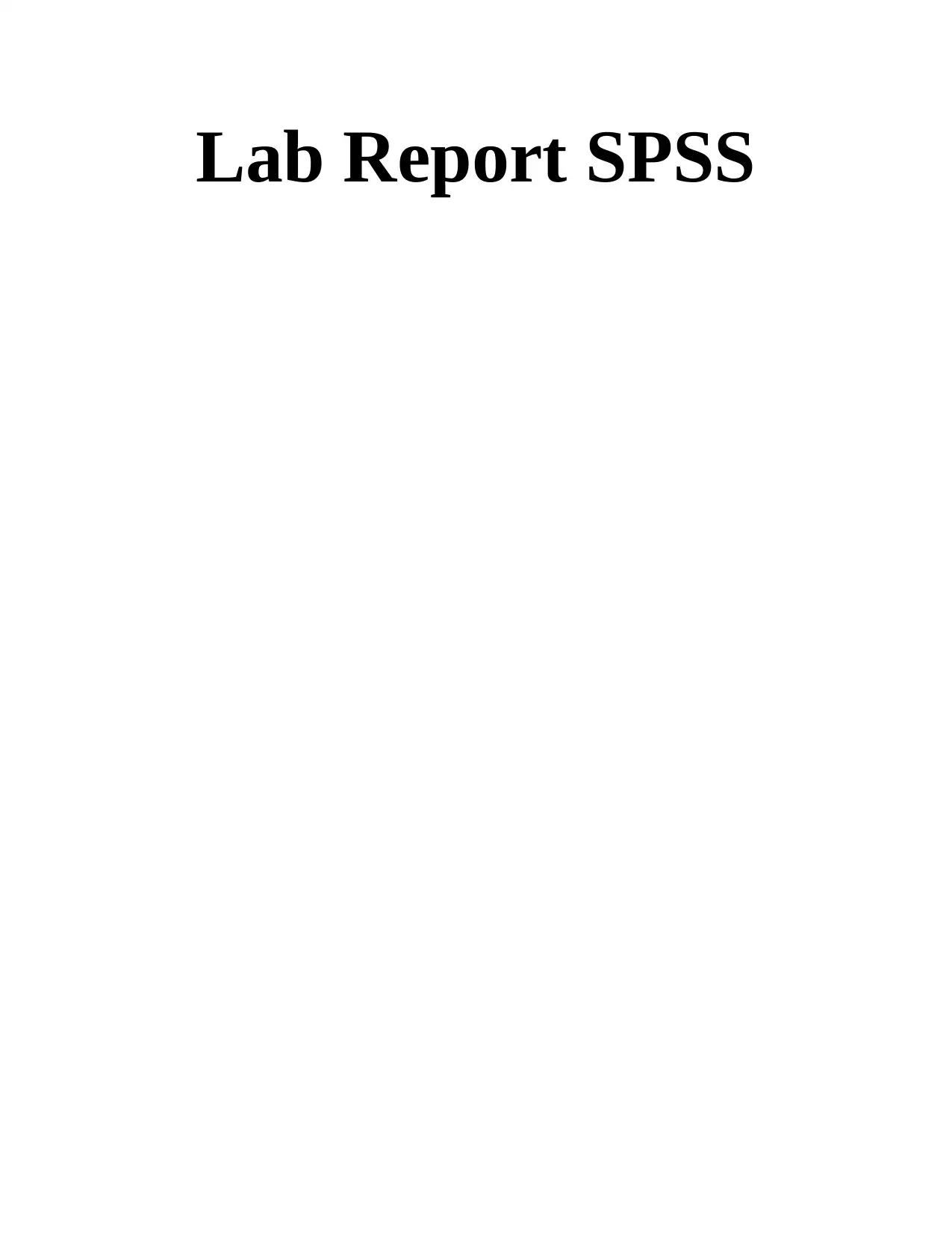
Lab Report SPSS
Secure Best Marks with AI Grader
Need help grading? Try our AI Grader for instant feedback on your assignments.
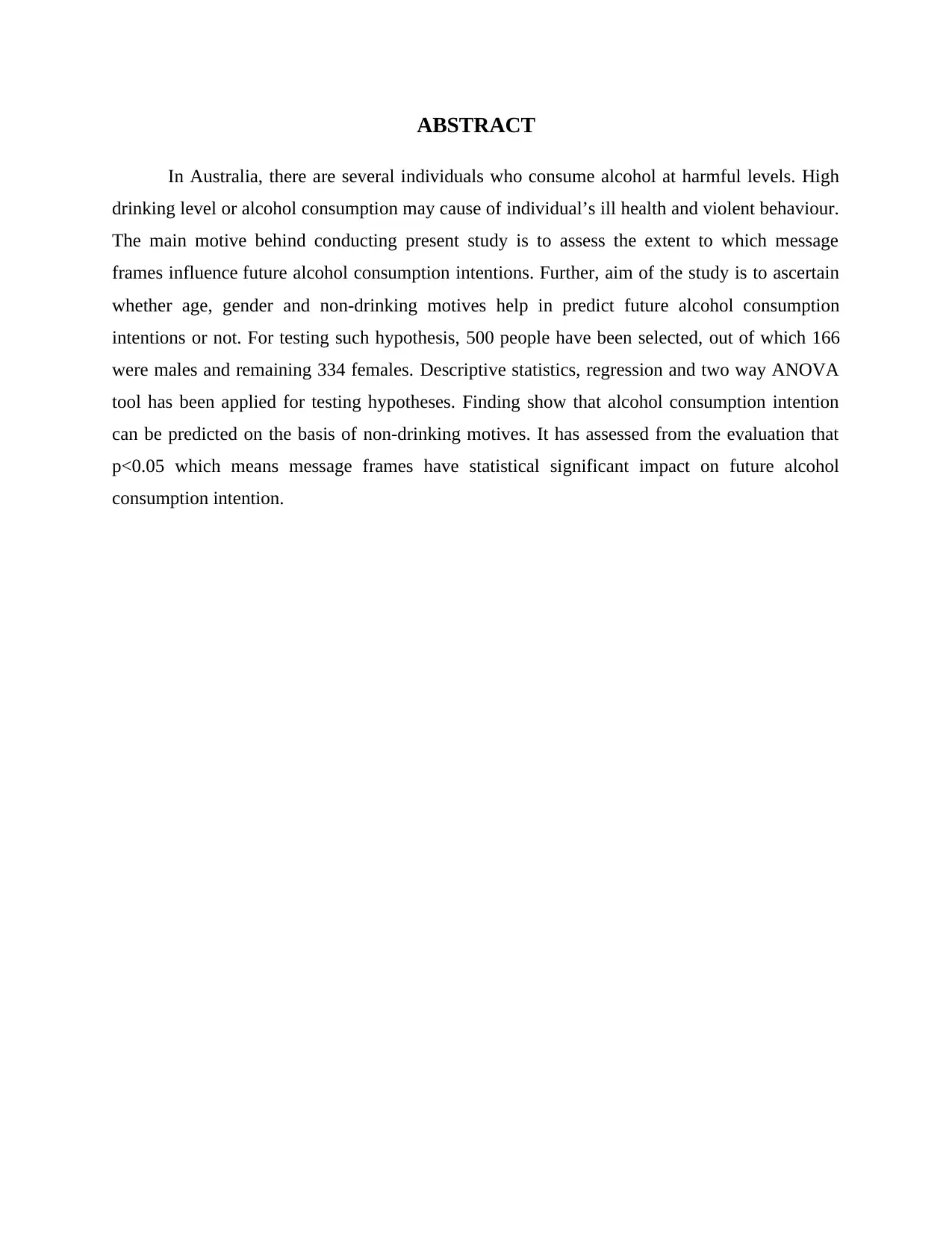
ABSTRACT
In Australia, there are several individuals who consume alcohol at harmful levels. High
drinking level or alcohol consumption may cause of individual’s ill health and violent behaviour.
The main motive behind conducting present study is to assess the extent to which message
frames influence future alcohol consumption intentions. Further, aim of the study is to ascertain
whether age, gender and non-drinking motives help in predict future alcohol consumption
intentions or not. For testing such hypothesis, 500 people have been selected, out of which 166
were males and remaining 334 females. Descriptive statistics, regression and two way ANOVA
tool has been applied for testing hypotheses. Finding show that alcohol consumption intention
can be predicted on the basis of non-drinking motives. It has assessed from the evaluation that
p<0.05 which means message frames have statistical significant impact on future alcohol
consumption intention.
In Australia, there are several individuals who consume alcohol at harmful levels. High
drinking level or alcohol consumption may cause of individual’s ill health and violent behaviour.
The main motive behind conducting present study is to assess the extent to which message
frames influence future alcohol consumption intentions. Further, aim of the study is to ascertain
whether age, gender and non-drinking motives help in predict future alcohol consumption
intentions or not. For testing such hypothesis, 500 people have been selected, out of which 166
were males and remaining 334 females. Descriptive statistics, regression and two way ANOVA
tool has been applied for testing hypotheses. Finding show that alcohol consumption intention
can be predicted on the basis of non-drinking motives. It has assessed from the evaluation that
p<0.05 which means message frames have statistical significant impact on future alcohol
consumption intention.
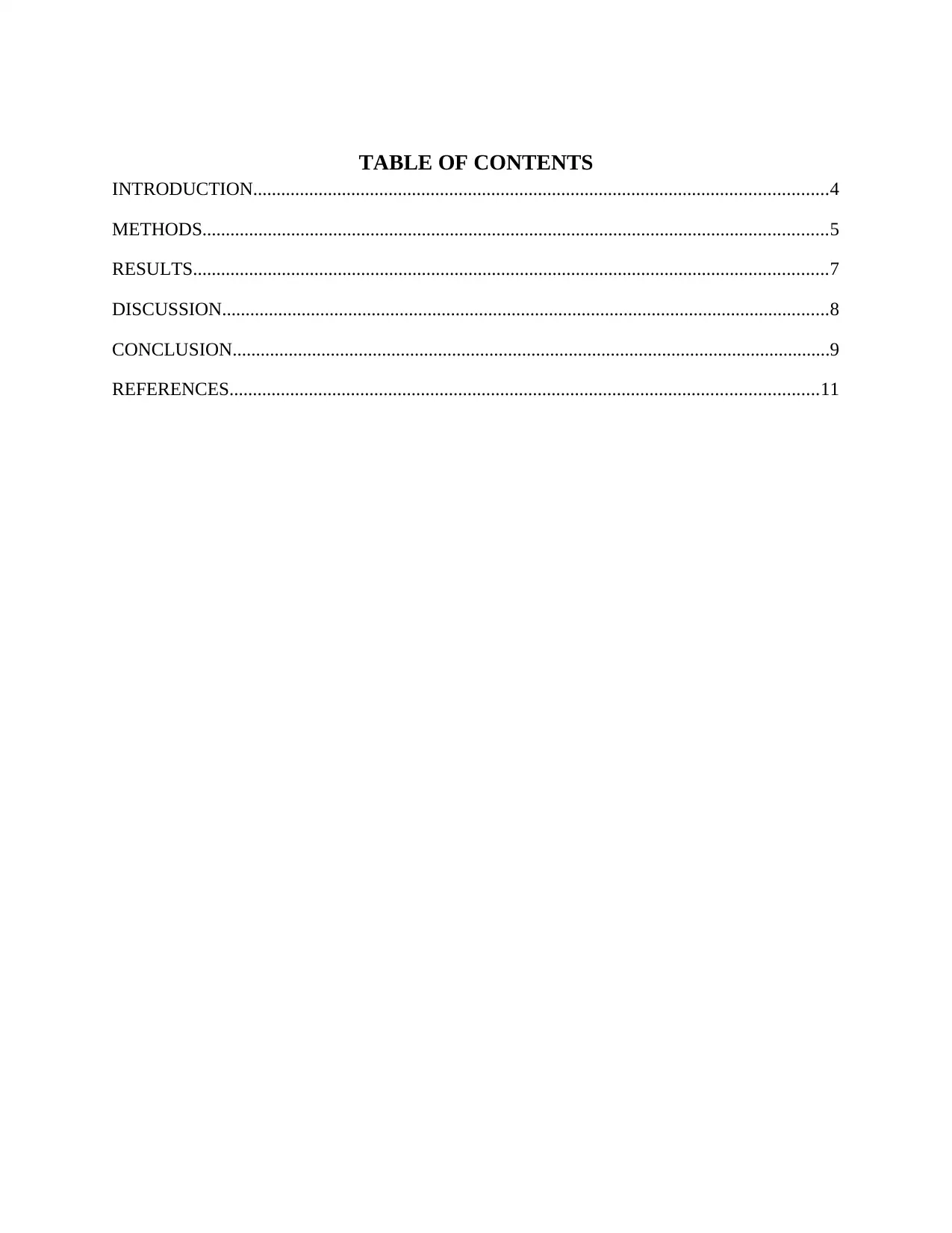
TABLE OF CONTENTS
INTRODUCTION...........................................................................................................................4
METHODS......................................................................................................................................5
RESULTS........................................................................................................................................7
DISCUSSION..................................................................................................................................8
CONCLUSION................................................................................................................................9
REFERENCES..............................................................................................................................11
INTRODUCTION...........................................................................................................................4
METHODS......................................................................................................................................5
RESULTS........................................................................................................................................7
DISCUSSION..................................................................................................................................8
CONCLUSION................................................................................................................................9
REFERENCES..............................................................................................................................11
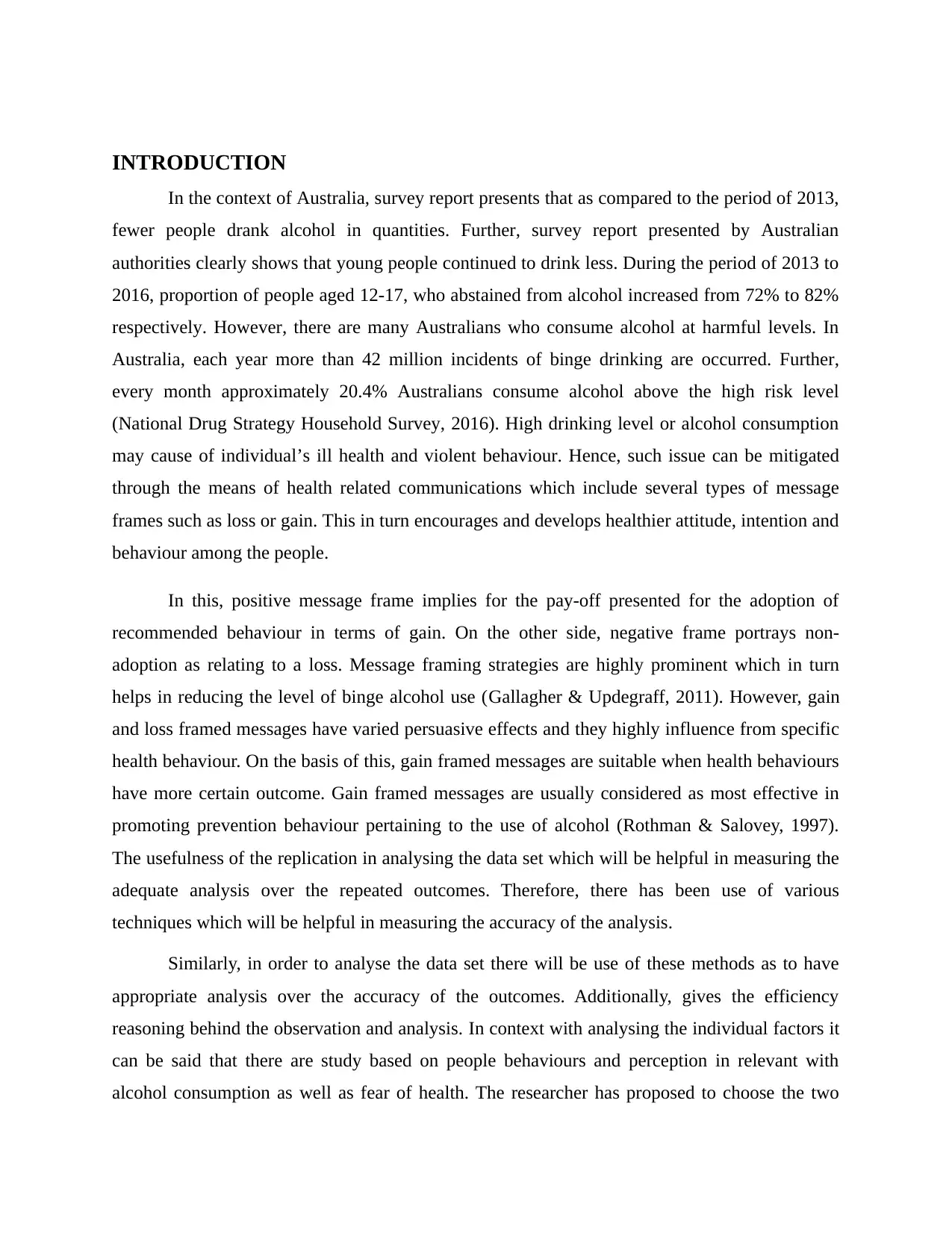
INTRODUCTION
In the context of Australia, survey report presents that as compared to the period of 2013,
fewer people drank alcohol in quantities. Further, survey report presented by Australian
authorities clearly shows that young people continued to drink less. During the period of 2013 to
2016, proportion of people aged 12-17, who abstained from alcohol increased from 72% to 82%
respectively. However, there are many Australians who consume alcohol at harmful levels. In
Australia, each year more than 42 million incidents of binge drinking are occurred. Further,
every month approximately 20.4% Australians consume alcohol above the high risk level
(National Drug Strategy Household Survey, 2016). High drinking level or alcohol consumption
may cause of individual’s ill health and violent behaviour. Hence, such issue can be mitigated
through the means of health related communications which include several types of message
frames such as loss or gain. This in turn encourages and develops healthier attitude, intention and
behaviour among the people.
In this, positive message frame implies for the pay-off presented for the adoption of
recommended behaviour in terms of gain. On the other side, negative frame portrays non-
adoption as relating to a loss. Message framing strategies are highly prominent which in turn
helps in reducing the level of binge alcohol use (Gallagher & Updegraff, 2011). However, gain
and loss framed messages have varied persuasive effects and they highly influence from specific
health behaviour. On the basis of this, gain framed messages are suitable when health behaviours
have more certain outcome. Gain framed messages are usually considered as most effective in
promoting prevention behaviour pertaining to the use of alcohol (Rothman & Salovey, 1997).
The usefulness of the replication in analysing the data set which will be helpful in measuring the
adequate analysis over the repeated outcomes. Therefore, there has been use of various
techniques which will be helpful in measuring the accuracy of the analysis.
Similarly, in order to analyse the data set there will be use of these methods as to have
appropriate analysis over the accuracy of the outcomes. Additionally, gives the efficiency
reasoning behind the observation and analysis. In context with analysing the individual factors it
can be said that there are study based on people behaviours and perception in relevant with
alcohol consumption as well as fear of health. The researcher has proposed to choose the two
In the context of Australia, survey report presents that as compared to the period of 2013,
fewer people drank alcohol in quantities. Further, survey report presented by Australian
authorities clearly shows that young people continued to drink less. During the period of 2013 to
2016, proportion of people aged 12-17, who abstained from alcohol increased from 72% to 82%
respectively. However, there are many Australians who consume alcohol at harmful levels. In
Australia, each year more than 42 million incidents of binge drinking are occurred. Further,
every month approximately 20.4% Australians consume alcohol above the high risk level
(National Drug Strategy Household Survey, 2016). High drinking level or alcohol consumption
may cause of individual’s ill health and violent behaviour. Hence, such issue can be mitigated
through the means of health related communications which include several types of message
frames such as loss or gain. This in turn encourages and develops healthier attitude, intention and
behaviour among the people.
In this, positive message frame implies for the pay-off presented for the adoption of
recommended behaviour in terms of gain. On the other side, negative frame portrays non-
adoption as relating to a loss. Message framing strategies are highly prominent which in turn
helps in reducing the level of binge alcohol use (Gallagher & Updegraff, 2011). However, gain
and loss framed messages have varied persuasive effects and they highly influence from specific
health behaviour. On the basis of this, gain framed messages are suitable when health behaviours
have more certain outcome. Gain framed messages are usually considered as most effective in
promoting prevention behaviour pertaining to the use of alcohol (Rothman & Salovey, 1997).
The usefulness of the replication in analysing the data set which will be helpful in measuring the
adequate analysis over the repeated outcomes. Therefore, there has been use of various
techniques which will be helpful in measuring the accuracy of the analysis.
Similarly, in order to analyse the data set there will be use of these methods as to have
appropriate analysis over the accuracy of the outcomes. Additionally, gives the efficiency
reasoning behind the observation and analysis. In context with analysing the individual factors it
can be said that there are study based on people behaviours and perception in relevant with
alcohol consumption as well as fear of health. The researcher has proposed to choose the two
Secure Best Marks with AI Grader
Need help grading? Try our AI Grader for instant feedback on your assignments.
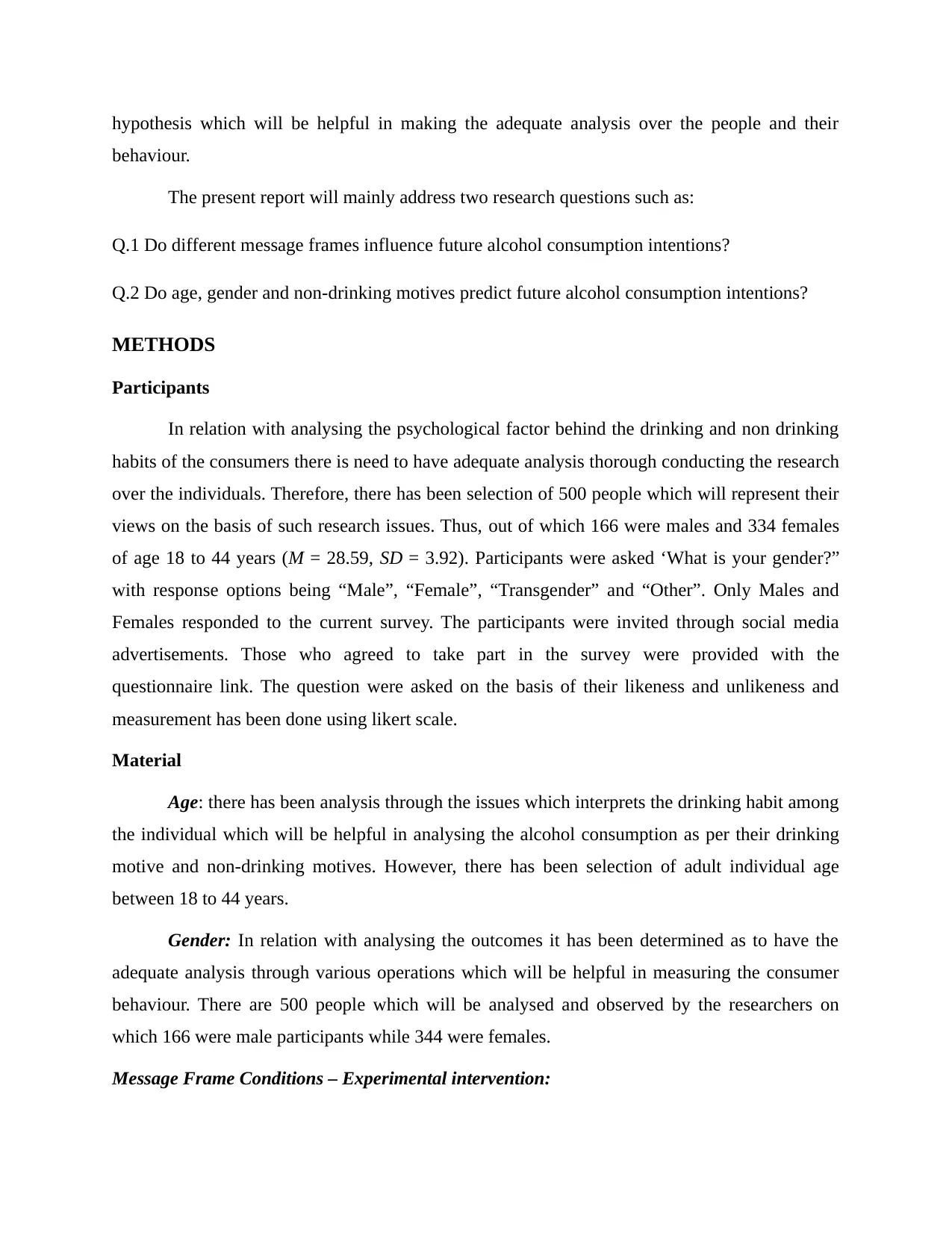
hypothesis which will be helpful in making the adequate analysis over the people and their
behaviour.
The present report will mainly address two research questions such as:
Q.1 Do different message frames influence future alcohol consumption intentions?
Q.2 Do age, gender and non-drinking motives predict future alcohol consumption intentions?
METHODS
Participants
In relation with analysing the psychological factor behind the drinking and non drinking
habits of the consumers there is need to have adequate analysis thorough conducting the research
over the individuals. Therefore, there has been selection of 500 people which will represent their
views on the basis of such research issues. Thus, out of which 166 were males and 334 females
of age 18 to 44 years (M = 28.59, SD = 3.92). Participants were asked ‘What is your gender?”
with response options being “Male”, “Female”, “Transgender” and “Other”. Only Males and
Females responded to the current survey. The participants were invited through social media
advertisements. Those who agreed to take part in the survey were provided with the
questionnaire link. The question were asked on the basis of their likeness and unlikeness and
measurement has been done using likert scale.
Material
Age: there has been analysis through the issues which interprets the drinking habit among
the individual which will be helpful in analysing the alcohol consumption as per their drinking
motive and non-drinking motives. However, there has been selection of adult individual age
between 18 to 44 years.
Gender: In relation with analysing the outcomes it has been determined as to have the
adequate analysis through various operations which will be helpful in measuring the consumer
behaviour. There are 500 people which will be analysed and observed by the researchers on
which 166 were male participants while 344 were females.
Message Frame Conditions – Experimental intervention:
behaviour.
The present report will mainly address two research questions such as:
Q.1 Do different message frames influence future alcohol consumption intentions?
Q.2 Do age, gender and non-drinking motives predict future alcohol consumption intentions?
METHODS
Participants
In relation with analysing the psychological factor behind the drinking and non drinking
habits of the consumers there is need to have adequate analysis thorough conducting the research
over the individuals. Therefore, there has been selection of 500 people which will represent their
views on the basis of such research issues. Thus, out of which 166 were males and 334 females
of age 18 to 44 years (M = 28.59, SD = 3.92). Participants were asked ‘What is your gender?”
with response options being “Male”, “Female”, “Transgender” and “Other”. Only Males and
Females responded to the current survey. The participants were invited through social media
advertisements. Those who agreed to take part in the survey were provided with the
questionnaire link. The question were asked on the basis of their likeness and unlikeness and
measurement has been done using likert scale.
Material
Age: there has been analysis through the issues which interprets the drinking habit among
the individual which will be helpful in analysing the alcohol consumption as per their drinking
motive and non-drinking motives. However, there has been selection of adult individual age
between 18 to 44 years.
Gender: In relation with analysing the outcomes it has been determined as to have the
adequate analysis through various operations which will be helpful in measuring the consumer
behaviour. There are 500 people which will be analysed and observed by the researchers on
which 166 were male participants while 344 were females.
Message Frame Conditions – Experimental intervention:
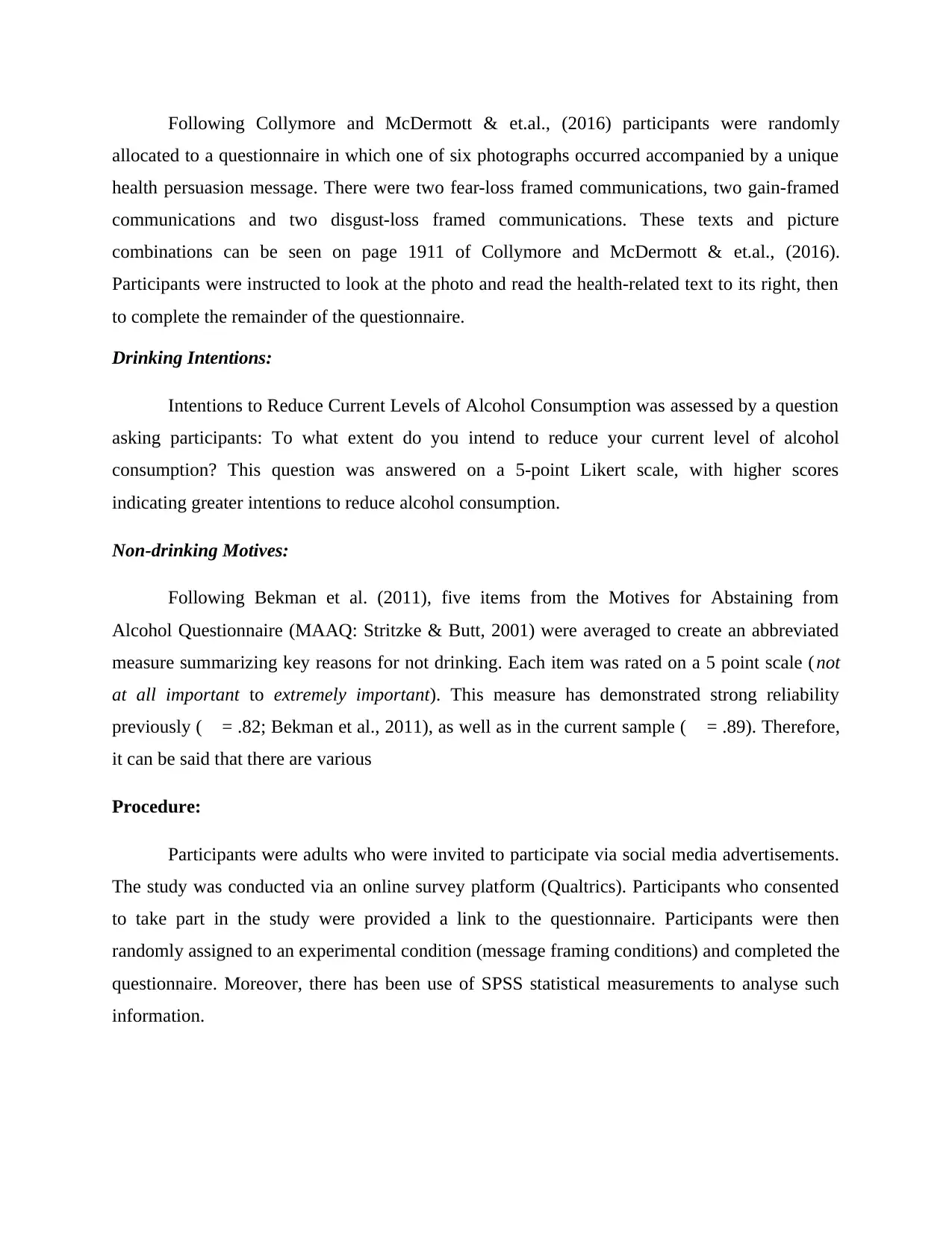
Following Collymore and McDermott & et.al., (2016) participants were randomly
allocated to a questionnaire in which one of six photographs occurred accompanied by a unique
health persuasion message. There were two fear-loss framed communications, two gain-framed
communications and two disgust-loss framed communications. These texts and picture
combinations can be seen on page 1911 of Collymore and McDermott & et.al., (2016).
Participants were instructed to look at the photo and read the health-related text to its right, then
to complete the remainder of the questionnaire.
Drinking Intentions:
Intentions to Reduce Current Levels of Alcohol Consumption was assessed by a question
asking participants: To what extent do you intend to reduce your current level of alcohol
consumption? This question was answered on a 5-point Likert scale, with higher scores
indicating greater intentions to reduce alcohol consumption.
Non-drinking Motives:
Following Bekman et al. (2011), five items from the Motives for Abstaining from
Alcohol Questionnaire (MAAQ: Stritzke & Butt, 2001) were averaged to create an abbreviated
measure summarizing key reasons for not drinking. Each item was rated on a 5 point scale ( not
at all important to extremely important). This measure has demonstrated strong reliability
previously ( = .82; Bekman et al., 2011), as well as in the current sample ( = .89). Therefore,
it can be said that there are various
Procedure:
Participants were adults who were invited to participate via social media advertisements.
The study was conducted via an online survey platform (Qualtrics). Participants who consented
to take part in the study were provided a link to the questionnaire. Participants were then
randomly assigned to an experimental condition (message framing conditions) and completed the
questionnaire. Moreover, there has been use of SPSS statistical measurements to analyse such
information.
allocated to a questionnaire in which one of six photographs occurred accompanied by a unique
health persuasion message. There were two fear-loss framed communications, two gain-framed
communications and two disgust-loss framed communications. These texts and picture
combinations can be seen on page 1911 of Collymore and McDermott & et.al., (2016).
Participants were instructed to look at the photo and read the health-related text to its right, then
to complete the remainder of the questionnaire.
Drinking Intentions:
Intentions to Reduce Current Levels of Alcohol Consumption was assessed by a question
asking participants: To what extent do you intend to reduce your current level of alcohol
consumption? This question was answered on a 5-point Likert scale, with higher scores
indicating greater intentions to reduce alcohol consumption.
Non-drinking Motives:
Following Bekman et al. (2011), five items from the Motives for Abstaining from
Alcohol Questionnaire (MAAQ: Stritzke & Butt, 2001) were averaged to create an abbreviated
measure summarizing key reasons for not drinking. Each item was rated on a 5 point scale ( not
at all important to extremely important). This measure has demonstrated strong reliability
previously ( = .82; Bekman et al., 2011), as well as in the current sample ( = .89). Therefore,
it can be said that there are various
Procedure:
Participants were adults who were invited to participate via social media advertisements.
The study was conducted via an online survey platform (Qualtrics). Participants who consented
to take part in the study were provided a link to the questionnaire. Participants were then
randomly assigned to an experimental condition (message framing conditions) and completed the
questionnaire. Moreover, there has been use of SPSS statistical measurements to analyse such
information.
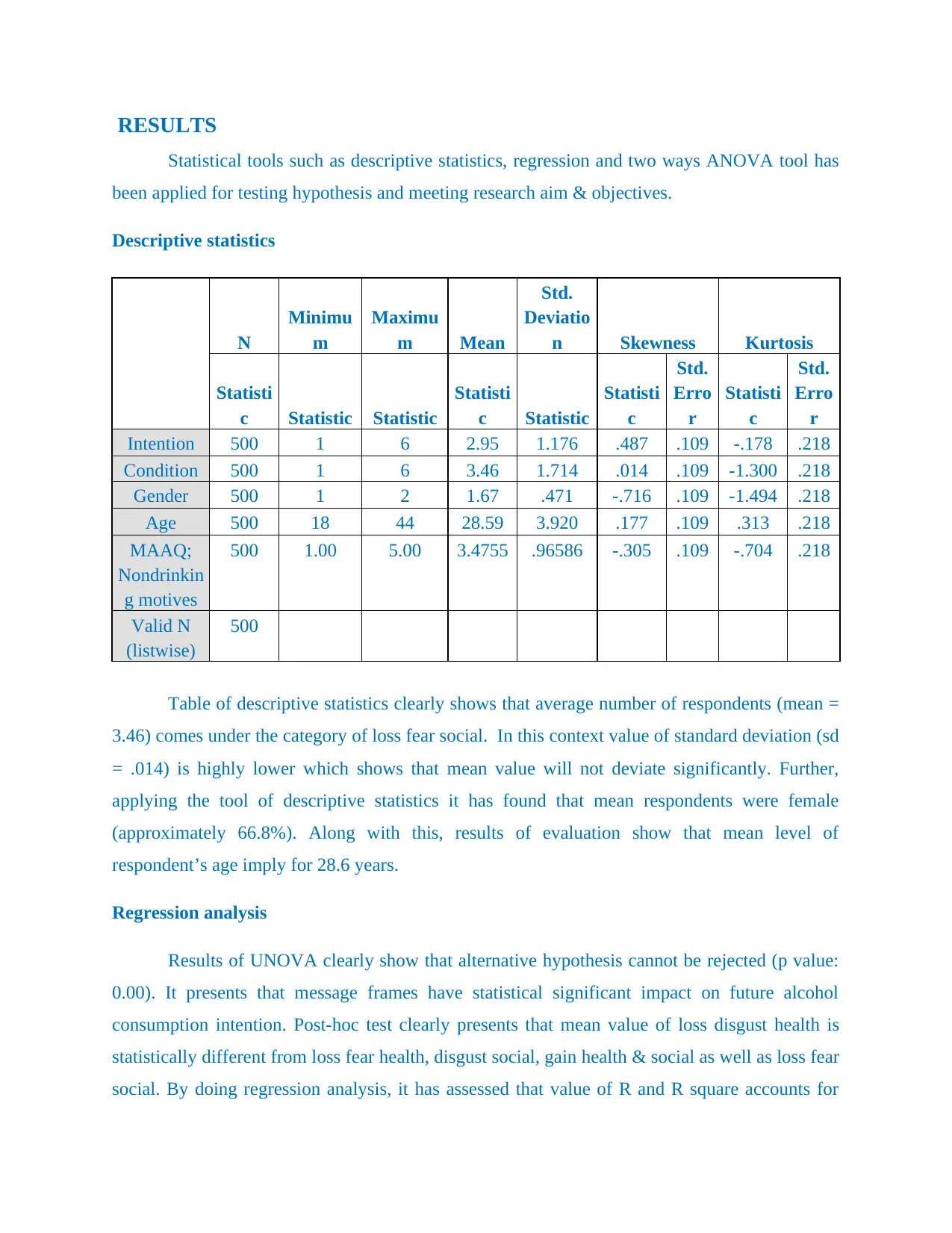
RESULTS
Statistical tools such as descriptive statistics, regression and two ways ANOVA tool has
been applied for testing hypothesis and meeting research aim & objectives.
Descriptive statistics
N
Minimu
m
Maximu
m Mean
Std.
Deviatio
n Skewness Kurtosis
Statisti
c Statistic Statistic
Statisti
c Statistic
Statisti
c
Std.
Erro
r
Statisti
c
Std.
Erro
r
Intention 500 1 6 2.95 1.176 .487 .109 -.178 .218
Condition 500 1 6 3.46 1.714 .014 .109 -1.300 .218
Gender 500 1 2 1.67 .471 -.716 .109 -1.494 .218
Age 500 18 44 28.59 3.920 .177 .109 .313 .218
MAAQ;
Nondrinkin
g motives
500 1.00 5.00 3.4755 .96586 -.305 .109 -.704 .218
Valid N
(listwise)
500
Table of descriptive statistics clearly shows that average number of respondents (mean =
3.46) comes under the category of loss fear social. In this context value of standard deviation (sd
= .014) is highly lower which shows that mean value will not deviate significantly. Further,
applying the tool of descriptive statistics it has found that mean respondents were female
(approximately 66.8%). Along with this, results of evaluation show that mean level of
respondent’s age imply for 28.6 years.
Regression analysis
Results of UNOVA clearly show that alternative hypothesis cannot be rejected (p value:
0.00). It presents that message frames have statistical significant impact on future alcohol
consumption intention. Post-hoc test clearly presents that mean value of loss disgust health is
statistically different from loss fear health, disgust social, gain health & social as well as loss fear
social. By doing regression analysis, it has assessed that value of R and R square accounts for
Statistical tools such as descriptive statistics, regression and two ways ANOVA tool has
been applied for testing hypothesis and meeting research aim & objectives.
Descriptive statistics
N
Minimu
m
Maximu
m Mean
Std.
Deviatio
n Skewness Kurtosis
Statisti
c Statistic Statistic
Statisti
c Statistic
Statisti
c
Std.
Erro
r
Statisti
c
Std.
Erro
r
Intention 500 1 6 2.95 1.176 .487 .109 -.178 .218
Condition 500 1 6 3.46 1.714 .014 .109 -1.300 .218
Gender 500 1 2 1.67 .471 -.716 .109 -1.494 .218
Age 500 18 44 28.59 3.920 .177 .109 .313 .218
MAAQ;
Nondrinkin
g motives
500 1.00 5.00 3.4755 .96586 -.305 .109 -.704 .218
Valid N
(listwise)
500
Table of descriptive statistics clearly shows that average number of respondents (mean =
3.46) comes under the category of loss fear social. In this context value of standard deviation (sd
= .014) is highly lower which shows that mean value will not deviate significantly. Further,
applying the tool of descriptive statistics it has found that mean respondents were female
(approximately 66.8%). Along with this, results of evaluation show that mean level of
respondent’s age imply for 28.6 years.
Regression analysis
Results of UNOVA clearly show that alternative hypothesis cannot be rejected (p value:
0.00). It presents that message frames have statistical significant impact on future alcohol
consumption intention. Post-hoc test clearly presents that mean value of loss disgust health is
statistically different from loss fear health, disgust social, gain health & social as well as loss fear
social. By doing regression analysis, it has assessed that value of R and R square accounts for
Paraphrase This Document
Need a fresh take? Get an instant paraphrase of this document with our AI Paraphraser
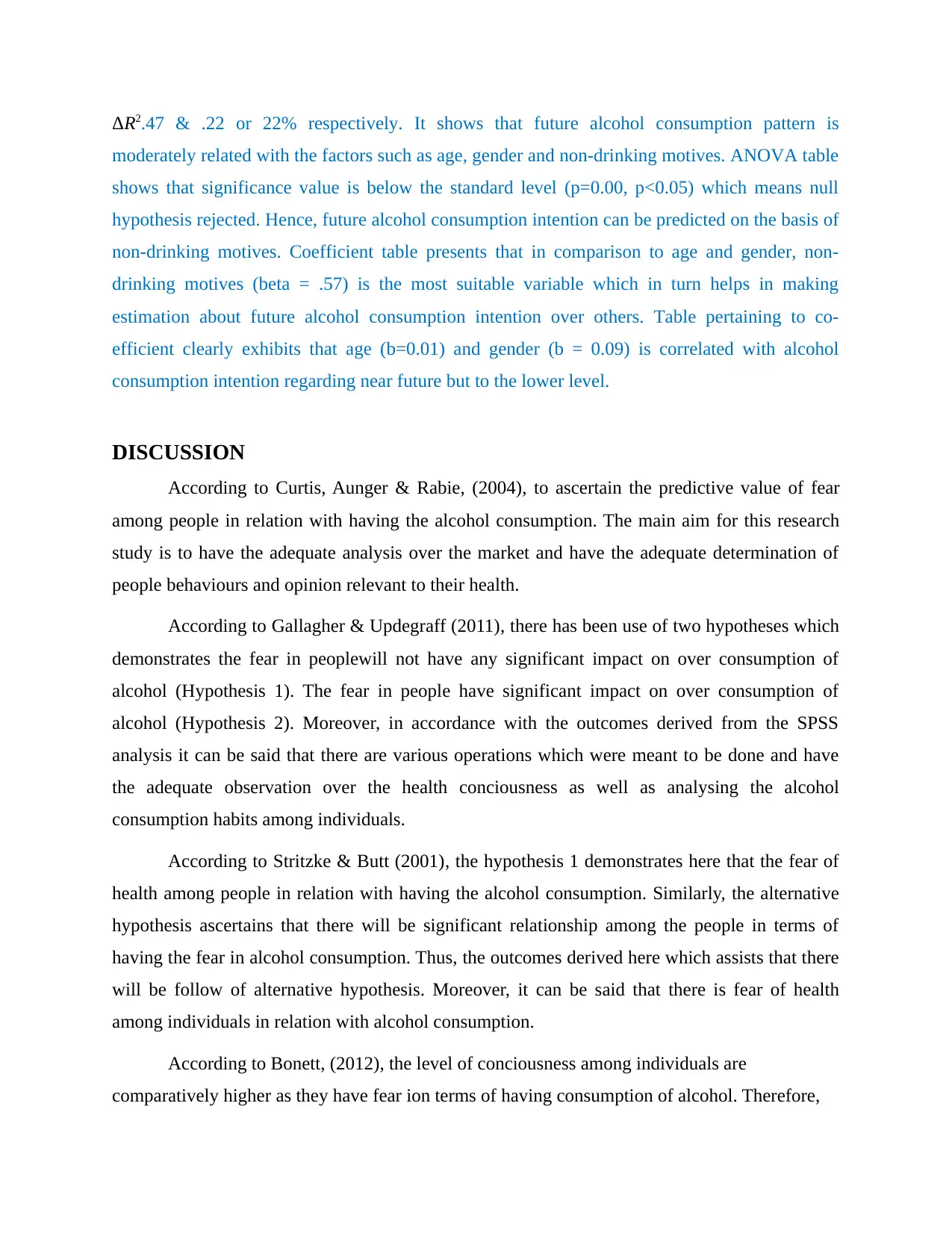
ΔR2.47 & .22 or 22% respectively. It shows that future alcohol consumption pattern is
moderately related with the factors such as age, gender and non-drinking motives. ANOVA table
shows that significance value is below the standard level (p=0.00, p<0.05) which means null
hypothesis rejected. Hence, future alcohol consumption intention can be predicted on the basis of
non-drinking motives. Coefficient table presents that in comparison to age and gender, non-
drinking motives (beta = .57) is the most suitable variable which in turn helps in making
estimation about future alcohol consumption intention over others. Table pertaining to co-
efficient clearly exhibits that age (b=0.01) and gender (b = 0.09) is correlated with alcohol
consumption intention regarding near future but to the lower level.
DISCUSSION
According to Curtis, Aunger & Rabie, (2004), to ascertain the predictive value of fear
among people in relation with having the alcohol consumption. The main aim for this research
study is to have the adequate analysis over the market and have the adequate determination of
people behaviours and opinion relevant to their health.
According to Gallagher & Updegraff (2011), there has been use of two hypotheses which
demonstrates the fear in peoplewill not have any significant impact on over consumption of
alcohol (Hypothesis 1). The fear in people have significant impact on over consumption of
alcohol (Hypothesis 2). Moreover, in accordance with the outcomes derived from the SPSS
analysis it can be said that there are various operations which were meant to be done and have
the adequate observation over the health conciousness as well as analysing the alcohol
consumption habits among individuals.
According to Stritzke & Butt (2001), the hypothesis 1 demonstrates here that the fear of
health among people in relation with having the alcohol consumption. Similarly, the alternative
hypothesis ascertains that there will be significant relationship among the people in terms of
having the fear in alcohol consumption. Thus, the outcomes derived here which assists that there
will be follow of alternative hypothesis. Moreover, it can be said that there is fear of health
among individuals in relation with alcohol consumption.
According to Bonett, (2012), the level of conciousness among individuals are
comparatively higher as they have fear ion terms of having consumption of alcohol. Therefore,
moderately related with the factors such as age, gender and non-drinking motives. ANOVA table
shows that significance value is below the standard level (p=0.00, p<0.05) which means null
hypothesis rejected. Hence, future alcohol consumption intention can be predicted on the basis of
non-drinking motives. Coefficient table presents that in comparison to age and gender, non-
drinking motives (beta = .57) is the most suitable variable which in turn helps in making
estimation about future alcohol consumption intention over others. Table pertaining to co-
efficient clearly exhibits that age (b=0.01) and gender (b = 0.09) is correlated with alcohol
consumption intention regarding near future but to the lower level.
DISCUSSION
According to Curtis, Aunger & Rabie, (2004), to ascertain the predictive value of fear
among people in relation with having the alcohol consumption. The main aim for this research
study is to have the adequate analysis over the market and have the adequate determination of
people behaviours and opinion relevant to their health.
According to Gallagher & Updegraff (2011), there has been use of two hypotheses which
demonstrates the fear in peoplewill not have any significant impact on over consumption of
alcohol (Hypothesis 1). The fear in people have significant impact on over consumption of
alcohol (Hypothesis 2). Moreover, in accordance with the outcomes derived from the SPSS
analysis it can be said that there are various operations which were meant to be done and have
the adequate observation over the health conciousness as well as analysing the alcohol
consumption habits among individuals.
According to Stritzke & Butt (2001), the hypothesis 1 demonstrates here that the fear of
health among people in relation with having the alcohol consumption. Similarly, the alternative
hypothesis ascertains that there will be significant relationship among the people in terms of
having the fear in alcohol consumption. Thus, the outcomes derived here which assists that there
will be follow of alternative hypothesis. Moreover, it can be said that there is fear of health
among individuals in relation with alcohol consumption.
According to Bonett, (2012), the level of conciousness among individuals are
comparatively higher as they have fear ion terms of having consumption of alcohol. Therefore,
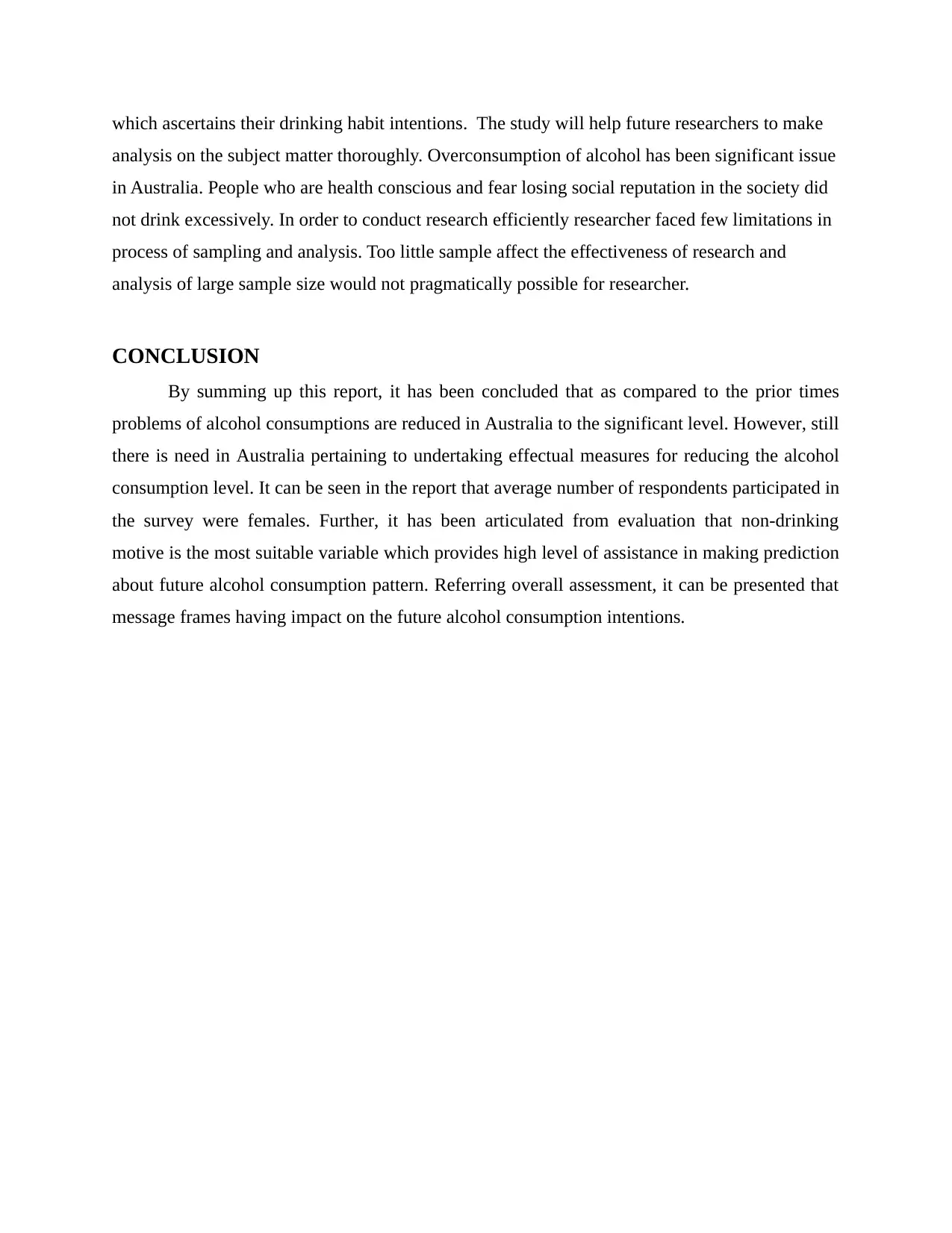
which ascertains their drinking habit intentions. The study will help future researchers to make
analysis on the subject matter thoroughly. Overconsumption of alcohol has been significant issue
in Australia. People who are health conscious and fear losing social reputation in the society did
not drink excessively. In order to conduct research efficiently researcher faced few limitations in
process of sampling and analysis. Too little sample affect the effectiveness of research and
analysis of large sample size would not pragmatically possible for researcher.
CONCLUSION
By summing up this report, it has been concluded that as compared to the prior times
problems of alcohol consumptions are reduced in Australia to the significant level. However, still
there is need in Australia pertaining to undertaking effectual measures for reducing the alcohol
consumption level. It can be seen in the report that average number of respondents participated in
the survey were females. Further, it has been articulated from evaluation that non-drinking
motive is the most suitable variable which provides high level of assistance in making prediction
about future alcohol consumption pattern. Referring overall assessment, it can be presented that
message frames having impact on the future alcohol consumption intentions.
analysis on the subject matter thoroughly. Overconsumption of alcohol has been significant issue
in Australia. People who are health conscious and fear losing social reputation in the society did
not drink excessively. In order to conduct research efficiently researcher faced few limitations in
process of sampling and analysis. Too little sample affect the effectiveness of research and
analysis of large sample size would not pragmatically possible for researcher.
CONCLUSION
By summing up this report, it has been concluded that as compared to the prior times
problems of alcohol consumptions are reduced in Australia to the significant level. However, still
there is need in Australia pertaining to undertaking effectual measures for reducing the alcohol
consumption level. It can be seen in the report that average number of respondents participated in
the survey were females. Further, it has been articulated from evaluation that non-drinking
motive is the most suitable variable which provides high level of assistance in making prediction
about future alcohol consumption pattern. Referring overall assessment, it can be presented that
message frames having impact on the future alcohol consumption intentions.
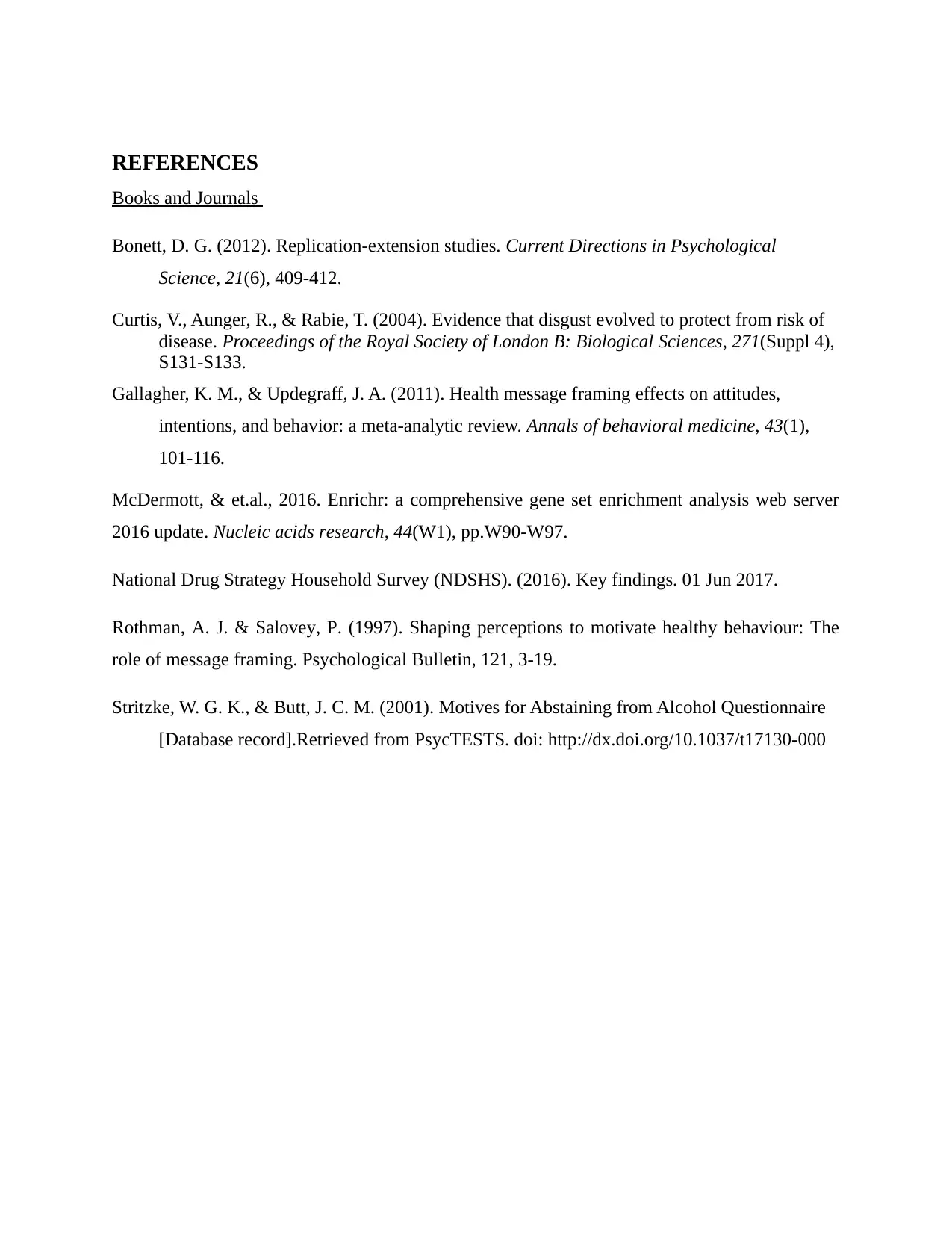
REFERENCES
Books and Journals
Bonett, D. G. (2012). Replication-extension studies. Current Directions in Psychological
Science, 21(6), 409-412.
Curtis, V., Aunger, R., & Rabie, T. (2004). Evidence that disgust evolved to protect from risk of
disease. Proceedings of the Royal Society of London B: Biological Sciences, 271(Suppl 4),
S131-S133.
Gallagher, K. M., & Updegraff, J. A. (2011). Health message framing effects on attitudes,
intentions, and behavior: a meta-analytic review. Annals of behavioral medicine, 43(1),
101-116.
McDermott, & et.al., 2016. Enrichr: a comprehensive gene set enrichment analysis web server
2016 update. Nucleic acids research, 44(W1), pp.W90-W97.
National Drug Strategy Household Survey (NDSHS). (2016). Key findings. 01 Jun 2017.
Rothman, A. J. & Salovey, P. (1997). Shaping perceptions to motivate healthy behaviour: The
role of message framing. Psychological Bulletin, 121, 3-19.
Stritzke, W. G. K., & Butt, J. C. M. (2001). Motives for Abstaining from Alcohol Questionnaire
[Database record].Retrieved from PsycTESTS. doi: http://dx.doi.org/10.1037/t17130-000
Books and Journals
Bonett, D. G. (2012). Replication-extension studies. Current Directions in Psychological
Science, 21(6), 409-412.
Curtis, V., Aunger, R., & Rabie, T. (2004). Evidence that disgust evolved to protect from risk of
disease. Proceedings of the Royal Society of London B: Biological Sciences, 271(Suppl 4),
S131-S133.
Gallagher, K. M., & Updegraff, J. A. (2011). Health message framing effects on attitudes,
intentions, and behavior: a meta-analytic review. Annals of behavioral medicine, 43(1),
101-116.
McDermott, & et.al., 2016. Enrichr: a comprehensive gene set enrichment analysis web server
2016 update. Nucleic acids research, 44(W1), pp.W90-W97.
National Drug Strategy Household Survey (NDSHS). (2016). Key findings. 01 Jun 2017.
Rothman, A. J. & Salovey, P. (1997). Shaping perceptions to motivate healthy behaviour: The
role of message framing. Psychological Bulletin, 121, 3-19.
Stritzke, W. G. K., & Butt, J. C. M. (2001). Motives for Abstaining from Alcohol Questionnaire
[Database record].Retrieved from PsycTESTS. doi: http://dx.doi.org/10.1037/t17130-000
1 out of 10
Related Documents
Your All-in-One AI-Powered Toolkit for Academic Success.
+13062052269
info@desklib.com
Available 24*7 on WhatsApp / Email
![[object Object]](/_next/static/media/star-bottom.7253800d.svg)
Unlock your academic potential
© 2024 | Zucol Services PVT LTD | All rights reserved.





